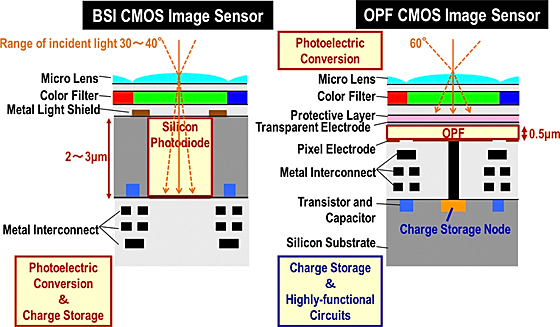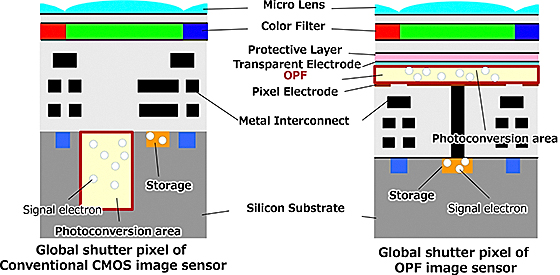For two years, Panasonic and Fujifilm have been collaborating on the development of an organic sensor and today Panasonic finally released some concrete information about the project. You can read the full press release on Panasonic’s website. Here we include the most interesting quotes from the press release, explain them in simple terms and add a few personal thoughts.
The new sensor is a highly functional global shutter technology for CMOS image sensor using organic photoconductive film (OPF). This tells us two things:
1. Organic technology
Further down in the press release Panasonic states that the organic photoconductive film (OPF) is developed by Fujifilm. So the sensor is designed by Panasonic and uses some technology made by Fujifilm. It would be interesting to know if Fujifilm will design its own version of the sensor with integrated OPF. Just last month the brand announced the building of a new plant in Taiwan to produce advanced semi-conductors.
The OPF CMOS Image Sensor Design Technology, in that, photoelectric-conversion part and a circuit part can be designed independently.
On current image sensors, the photoelectric conversion (transforming light coming through the lens into an electric signal) and the signal charge-storage function are executed by the photodiode. The new Panasonic sensor would make it possible to separate the two electric processes. The organic photoconductive film would take care of converting light to an electric signal while the circuits underneath it would be in charge of charge storage. Panasonic explains that because these two processes can be independent, the new image sensor can have the following benefits:
- Expansion of the incident light range to 60 degrees and reproduction of faithful color.
Traditional sensors can capture incident light at a maximum of 30-40°. The OPF is thinner than the silicon photodiode so the new sensor expands the range to 60°. The new sensor can capture more incident light which enhances faithful colour reproduction and can also facilitate lens design by keeping the overall size smaller.

- Boost of sensor sensitivity by 1.2 times compared to conventional silicon image sensors to deliver clear images, particularly in dark conditions.
With traditional sensors the effective quantity of light that can be captured by the photodiode is more limited because of the metal interconnect part and the existence of a metal light shield to prevent light from going to other areas than the photodiode. The new sensor uses the OPF technology not only to transform light into an electric signal but also as coating material for other parts of the pixel structure including the metal interconnect and transistor parts to gather more light. As a result the new sensor is 1.2 times more sensitive than traditional sensors.
- Design of OPF and circuits completely independent and realization of high-performance (high-saturation)
Because the photoelectric-conversion part and the circuit part are independent, the new sensor can use better high-performant circuits for high-speed or wide dynamic range. It can host a larger capacitor to store signal charge. Therefore the saturation value (max. amount of electric signal that can be captured before highlight clipping) can be higher than traditional sensor. Long story short, it means more information in the highlights and thus more dynamic range.
2. Global shutter technology
First we are talking about a global shutter sensor. Put in simple terms, it is an electronic shutter that gathers the incoming light to all photosites simultaneously instead of “scanning” from top to bottom like the electronic shutter options of our mirrorless cameras. That prevents any issues with rolling shutter. Global shutters are used mainly in expensive digital cinema cameras such as the Red and Arri Alexa cameras. Panasonic also has a digital cinema division so this new sensor could be primarily aimed at this area.

Photoelectric Conversion Controlled Global Shutter Technology that is realized by controlling of organic photoconductive film sensitivity.
Traditional CMOS sensors with a global shutter have the storage located near the photo-conversion area (light transformed into an electric signal). As a result enlarging the saturation signal (amount of electric signal before highlights are clipped) is more limited. The new sensor developed by Panasonic has a “Photoelectric conversion controlled global shutter technology” that allows for better control of the voltage without the need for additional circuits. This means the saturation signal is not degraded and the sensor can capture up to 10 times more signal per unit square pixel. Panasonic states that this technology will solve problems caused by rolling shutter distortion, flash bands and LED flickers in very bright scene.
Variable Sensitivity Multiple Exposure Technology which can detect the motion and its direction by changing image capturing sensitivity in each frame.
Panasonic has developed a “variable sensitivity multiple exposure technology” that makes it possible to control the voltage applied to the OPF with elapse of time. This means that several images of different exposure times and different exposure sensitivities can be gathered in one picture. This allows it to recognize a moving object and motion directions.
Conclusion
The press release is very technical and we are not engineers ourselves but it is still interesting to analyse the potential of the technology. If we summarise, we can say that it should have more sensitivity, more dynamic range, more faithful colour reproduction, and compatibility with lenses with a smaller design. The global shutter technology should prevent any rolling shutter and banding issues and also provide advanced moving object and motion direction detection.
Further information is lacking such as resolution for example and sensor size. We still don’t know when this technology will be ready for use and what the main field of use would be. It could be a high-end cinema camera first and perhaps other low-end products after that.

